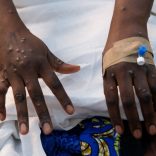Termination of allowances for Mozambican medical interns seems irreversible; the consequences ...
School meal rescued Samito from the streets in central Mozambique

Picture: Lusa
The Changara Elementary School, in central Mozambique, had long been sort of empty, but today it has become a refuge for many children.
Samito Emílio, six years old, lived in the streets of Changara, far from any family comfort and dependent on good will of people to feed himself.
These were difficult times for a child suffering from a congenital deficiency and who lost his parents very early, both to AIDS, an epidemic that is still a nightmare in Africa.
Samito has only one leg and two fingers of his right hand are melded together.
Jogging is a problem, and if it were not for the heavy makeshift crutches he carries with him every day, walking would be impossible.
Samito is shy and is almost always silent, preferring the darkness of his room to the light of the day, those who care for him say.
“He was a rejected boy and therefore always closed and sometimes aggressive,” Adélia Carlos, the owner of the orphanage that took the child in a year ago when he was abandoned by his parents’ family, tells Lusa.
In addition to Samito, Adélia Carlos cares for 20 other children in her modest orphanage, a project that depends on the small salary she earns as a teacher at Changara Elementary School.
The dormitories are small huts made of thatch, but, although there is sometimes nothing much to eat, there is love and community in abundance, she says.
“They all live together here, the others help Samito get on his crutches, they are all my children,” the old nun who decided to devote her life to the orphanage explains.
Samito’s future is not yet clear, but under the guidance of his adoptive mother, a taste for teaching seems to be an option.
Adélia Carlos has been fighting for him to go to school, and with the School Snack project, which serves food in educational establishments, there is hope that he might “leave the streets permanently”.
The project is funded by the World Food Program (WFP) in several provinces and it covers 37,000 children in Changara district alone , according to district government data.
Now, Samito even demands that he be taken to class.
“There are Saturdays when he wakes up, gets ready and says he wants to go to school,” despite it being the weekend, Adélia says.
According to the director of Changara District Education and Technology Services, Jonito José Antonio, the gains from this project benefit not only children but also small farmers, whose the schools with local products.
“Education goals are being achieved with the help of this project,” he notes.
The dropout rate in primary education has fallen from 10.5 to 1.5 percent in the last five years.
According to data from the WFP in the province of Tete, the project’s total budget is two million dollars per annum (EUR 1.7 million Euros), a figure that is invested, first, in the training of the small farmers who are going to supply schools and product management.
“Two important aspects for the continuity of this project are the warehouses and accountability,” says Karina Manente, WFP representative in Mozambique.
The menu feeding the dreams in Changara consists of cornmeal and beans one day, rice and greens the next.













Leave a Reply
Be the First to Comment!
You must be logged in to post a comment.
You must be logged in to post a comment.